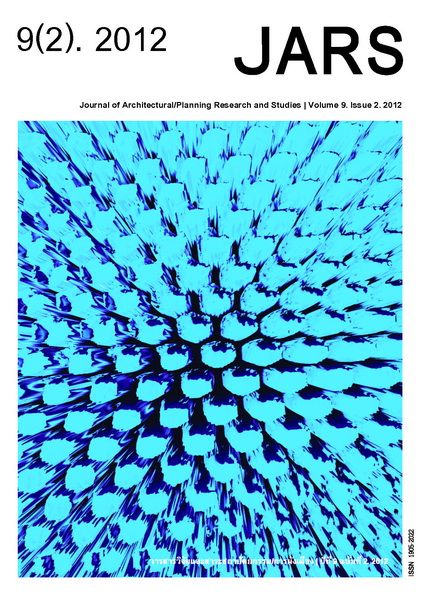Numerical Simulation of Forced Convective Heat Transfer Coefficients on Shaded Roofs with Wind Circulation in Low-Rise Buildings
Main Article Content
Abstract
The convective heat transfer coefficient at the external wall of the building is an important variable in the calculation of heat transfer through the building envelope. The average value of this variable has been estimated from the empirical equation of the wind speed around the building. This research used computational fluid dynamics program (CFD), Phoenics 3.5, to compute the convective heat transfer coefficients as the shading device is fixed on the roof regarding the wind separation and recirculation around the building. The results of the coefficient of convective heat transfer derived from modeling a building with no shading device were compared with the experimental results in previous research works. The simulation results were validated in the simulated model with turbulent flow using Large Eddy Simulation (LES). After that, the model with LES approach known as the standard Smagorinsky model (SMG) was applied to the building models with shading device on the roof. The results of this research are the convection coefficient values at the roof surface for a 1.8 meter channel between the roof and shading device and a roof in the wind direction with a length of 8.0, 20.0 and 36.0 meters, representing a 2-storey house and 4-storey buildings. The derived coefficients are proposed as power-law functions of fixed points on the roof and shading device surfaces. The highest convective heat transfer is predicted at the sharp upstream edge, two span-wise rims for the 4-storey building and most of the area of the 2-storey house. Installing eaves or placing buffer zones around the top floor of building is recommended in addition to the shading device on the roof.
Downloads
Article Details

This work is licensed under a Creative Commons Attribution-NonCommercial-NoDerivatives 4.0 International License.
All material is licensed under the terms of the Creative Commons Attribution 4.0 International (CC-BY-NC-ND 4.0) License, unless otherwise stated. As such, authors are free to share, copy, and redistribute the material in any medium or format. The authors must give appropriate credit, provide a link to the license, and indicate if changes were made. The authors may do so in any reasonable manner, but not in any way that suggests the licensor endorses you or your use. The authors may not use the material for commercial purposes. If the authors remix, transform, or build upon the material, they may not distribute the modified material, unless permission is obtained from JARS. Final, accepted versions of the paper may be posted on third party repositories, provided appropriate acknowledgement to the original source is clearly noted.
References
Blocken, B., Defraeye, T., Derome, D. & Carmeliet, J. (2009). High-resolution CFD simulations for forced convective heat transfer coefficients at the facade of a low-rise building. Building and Environment, 44, 2396–2412.
Concentration Heat and Momentum Limited [CHAM]. (2010). PHOENICS Documentation: TR 000. Retrieved April 18, 2012, from http://www.cham.co.uk/ChmSupport/tr000.php.
Cheng, Y., Lien, F. S., Yee, E. & Sinclair, R. (2003). A comparison of large Eddy simulations with a standard k–e Reynolds-averaged Navier–Stokes model for the prediction of a fully developed turbulent flow over a matrix of cubes. Journal of Wind Engineering and Industrial Aerodynamics, 91, 1301–1328.
Chungloo, S. (2007). Experimental and numerical studies of solar chimney and wetted roof: An application in the hot and humid climate. Ph.D. Thesis. Sirindhorn International Institute of Technology, Thammasat University, Kingdom of Thailand.
Givoni, B. (1994). Passive and low energy cooling of buildings. Wiley, New York.
Hagishima, A. & Tanimoto, J. (2003). Field measurements for estimating the convective heat transfer coefficient at building surfaces. Building and Environment, 38, 873–881.
Hemida, H., Spehr, F., Krajnovic, S. (2008). Local heat transfer enhancement around a matrix of wall-mounted cubes using passive flow control: Large-eddy simulations. International Journal of Heat and Fluid Flow, 29, 1258-1267.
Loveday, D. L. & Taki, A. H. (1996). Convective heat transfer coefficients at a plane surface on a full-scale building facade. lnt. J. Heat Mass Transfer, 39(8), 1729-42.
Meinders, E. R., Van der Meer, T. H. & Hanjali, K. (1998). Local convective heat transfer from an array of wallmounted cubes. International Journal of Heat and Fluid Flow, 41, 335-346.
Meinders, E. R. & Hanjali, K. (1999). Vortex structure and heat transfer in turbulent Flow over a wall-mounted matrix of cubes. International Journal of Heat and Fluid Flow, 20, 255-267.
Rodi, W. (1997). Comparison of LES and RANS calculation of the flow around bluff bodies. Journal of Wind Engineering and Industrial Aerodynamics, 69, 55-75.
Versteeg, H. K. & Malalasekra, W. (1995). An Introduction to Computational Fluid Dynamics: The Finite Volume Method. UK: Longman Scientific & Technical.


